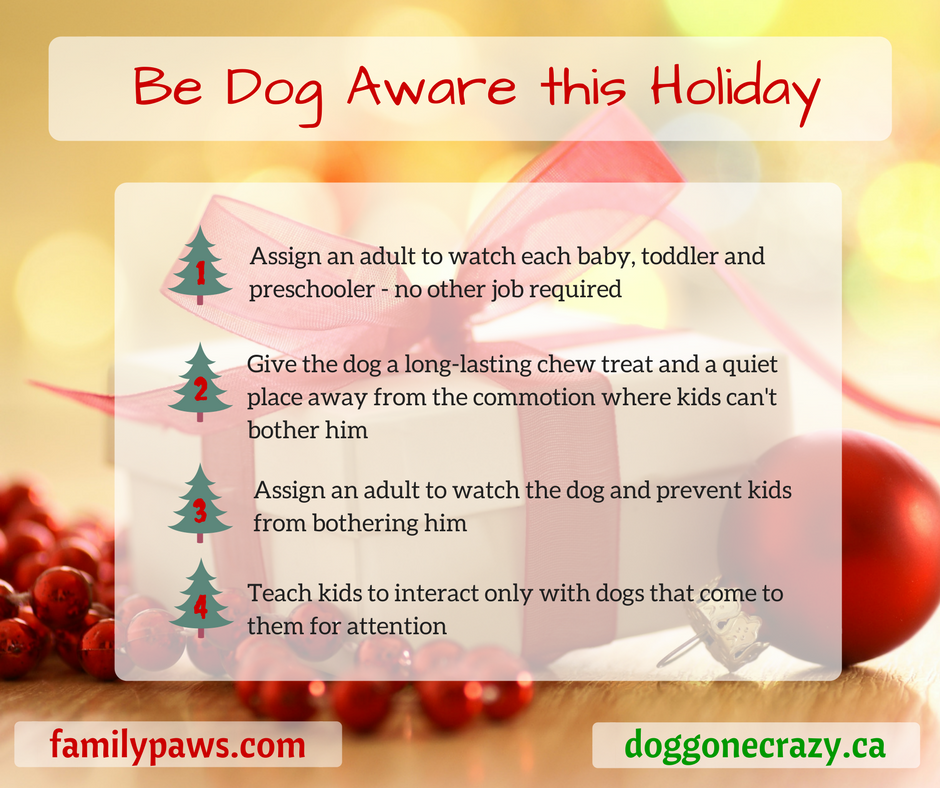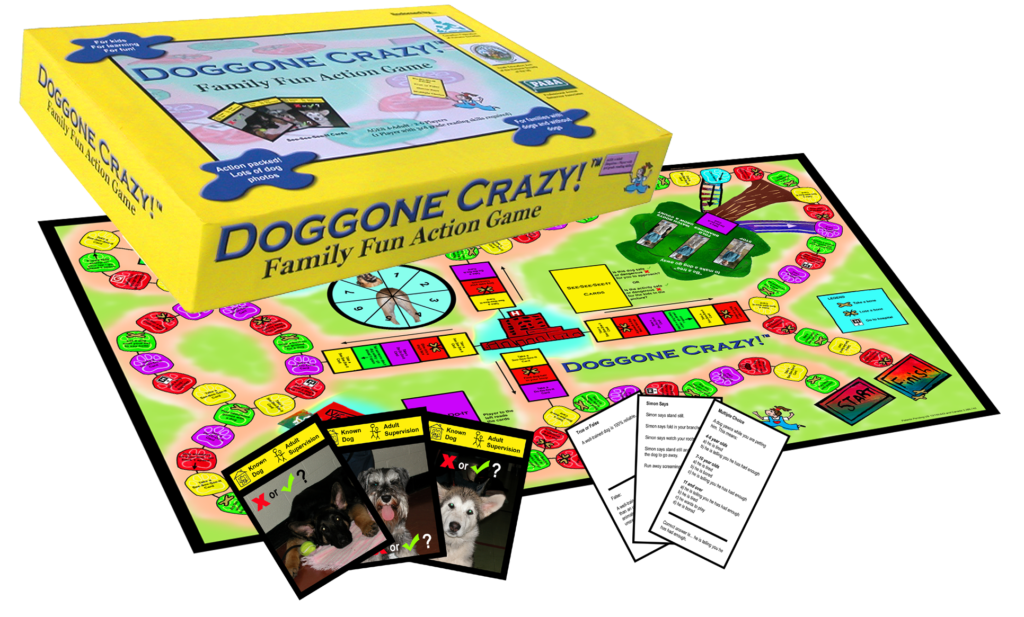
By Joan Orr and Teresa Lewin
Holidays Are Stressful for Dogs
Gatherings at a friend or relative’s house are the source of fond holiday memories for many. The family dog may not enjoy these events as much as everyone else. . Changes in routines, crowded rooms, unattended food and excited children can often lead to miscommunication between the family dog and guests. A stressed dog may be pushed to the limits of his tolerance and may feel he has no option but to defend himself. This is especially true of Grandma’s dog, who is used to a quiet and peaceful household. Even a normally calm and docile pet may become stressed and anxious under the extreme circumstances of a boisterous family celebration. Supervision may be lax if each adult thinks that another is watching the children.
When visiting a house with a dog, children should be taught to wait for the dog to approach them as opposed to going up to the dog (even if the dog has been friendly on other occasions). If the dog comes to them they should stand still like a tree and let the dog sniff. Only if the dog is wagging and panting and coming to them for attention, and parent and dog owners are supervising and have given permission, should a child touch the dog.
Gauge your dog’s reaction to visitors. If the dog is overly excited, barking or growling, cowering away, trying to hide or otherwise showing signs of anxiety or aggression, the dog should be kept separate from visiting children for the ENTIRE DURATION of the child’s visit. Give the dog its own place in a crate or another room with toys, a chew toy stuffed with goodies on and its special bed or blanket so that it can be happy and comfortable and away from guests. Even dogs who seem happy with visitors should never be alone in the room with visiting children. No preschooler, toddler or baby should be allowed to be near your dog unless you personally also have your hands on the dog and can prevent face to face contact between child and dog and can prevent the child from hugging or otherwise bothering the dog.
Greeting People at the Door
It’s a much calmer and more pleasant experience for everyone when the dog is not part of greeting visitors at the door. This is for the safety of the dog and the visitors. The dog is safer and happier if he starts off in a separate room or crate until the visitors are settled. Once the guests are settled, allow the dog to say hello if appropriate. If you are not sure about your dog, then leave him confined or keep him on a leash. Make sure that the dog associates visitors with something good for the dog, such as special treats or a stuffed chew toy.
Not the Time to Train the Dog
If you do perceive a problem between your dog and visiting children – THIS IS NOT THE TIME TO WORK ON IT. It is not reasonable to use visiting children to help train your dog. Take preventative measures to ensure that your dog doesn’t have the opportunity to bite and once the holiday season is over seek the help of a dog behaviour specialist who uses positive reinforcement methods to solve the dog’s problem.
Family Gatherings
Doggone Crazy offers the following tips for keeping dogs and kids safe and happy during holiday gatherings:
- Put the dog in his crate with a bone or favourite chew toy, at least during the most hectic times – guests arriving and leaving as well as dinner preparation and serving.
- Assign one adult to be in charge of the dog, to watch for signs of stress and protect from unwanted attention from children.
- Signs of stress include: The dog yawns or licks his chops. The dog shows the white part of his eye in a half moon shape.
- If the dog shows any of these signs, then he is worried and wants to be left alone. Put the dog in his crate or in a room away from the guests with a favourite chew toy or bone.
- If the dog licks his chops, yawns or shows the half moon eye when a child approaches or is petting him, intervene immediately and ensure that the child can’t access the dog.
- Don’t allow visiting children to hug the dog. Dogs don’t like hugs and kisses. Even if the dog tolerates this under normal circumstances he may not tolerate this from strangers or in a high stress situation with lots of noise and people.
- Other signs that the dog does not welcome attention from children (or adult) guests include the following:
The dog turns his head away, walks away or tries to hide under furniture.
The dog freezes and becomes very still, with his mouth closed. He may be staring intensely at the person who is bothering him and may growl. This dog is a few seconds away from a bite.
The dog growls or raises the fur along his back.
- Assign one adult to supervise each baby or toddler with no other tasks expected.
- If you have multiple dogs, consider kenneling them, crating them or keeping them in another room during large gatherings.
- Supervise at all times.
Need a Holiday Gift with a Doggie Theme?
Your kids will become doggie detectives and they’ll be teaching you things you never knew about dogs after they play the Doggone Crazy Board Game. They’ll know what the dogs is saying when he licks his nose, yawns or shows a half moon of white in his eye. They’ll know how to tell if a dog wants to meet them and whether their own dogs wants their attention. Most importantly they’ll learn a life saving skill that they’ll get to practice over and over in a fun way while playing the game.

More Information About How to Be Dog Aware
Visit Family Paws for tips and information from baby/toddler and dog relationship expert and dog behavior consultant Jennifer Shryock.